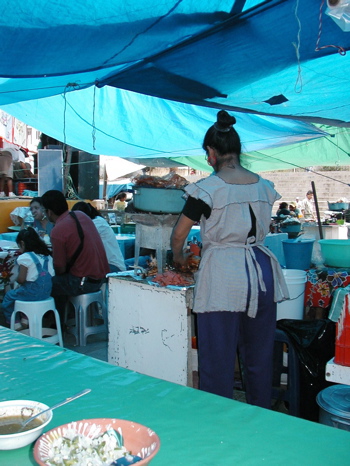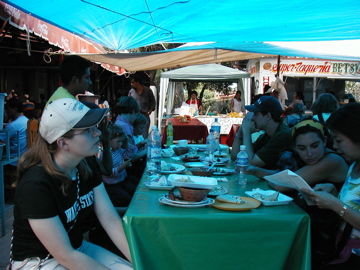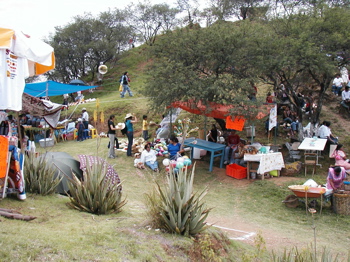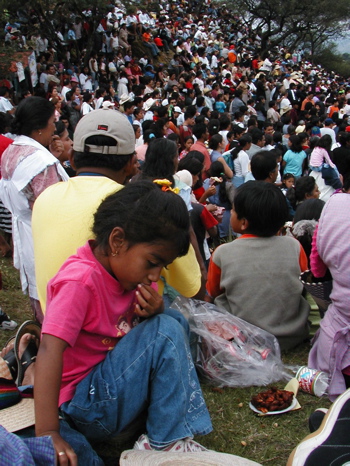7-26 Lunes del Cerro, Zaachila
Lunes del Cerro, which means "Monday of the Mountains"
Another big adventure, and one I was in no way prepared for.
I had a message at the house that we were to arrive an hour early at school so we could go to La Guelaguetza. I just couldn't figure that one out, since the doors to La Guelaguetza in Oaxaca open at 5 a.m. and the stadium fills up quite early and we didn't even have tickets. I couldn’t see how we would get seats.
Well, it turns out that we were indeed going to La Guelaguetza, but not in Oaxaca. We were going out to the smaller and more traditional festival in Zaachila, which is a little town about 10 miles to the east.
We were to be at school an hour early to have class before we went. So we studied for 2 hours, then went to the bus terminal to go on a crowded, hot bus to Zaachila. It cost 4 pesos - about 40 cents.
Zaachila seemed like nothing much was going on. It was really quiet. There was a little market just setting up and an archeological site that was open to the public but the tombs werentt open. At the site, there was a stage set up at the base of a hill with a couple hundred chairs around it. There were a few people selling barbecue, alegrias (candy made of amaranth seeds - kind of like candy corn) and roasted peanuts.
We went back down to the mercado and got lunch. Sabine, the other vegetarian and I got quesadillas filled with squash blossoms and cheese, deep fried, 2 for a buck. They were super tasty and excellent.
The other students ate barbacoa. It was either sheep or goat, I couldn't tell, though I watched the woman peel the meat off the animal's skull - standing there with her fingers through the eyeholes, cleaning that sucker off real good.

Cleaning the skull
They all seemed to enjoy the barbacoa. We ate outside at tables under the shade of blue plastic tarps, the official roofing material of Mexican markets.

My class eating lunch in Zaachila
I even drank a jamaica (hibiscus-flower) water sold by a woman vending from a tray - forgetting when I ordered that it had ice in it, which is what people all warn against. I drank it and prayed for protection from las turistas.
At the market, people were selling things you never see in the US. Yellow cherries, pitahaya (dragon cactus fruit), squash shoots. They were also selling the other usual stuff - masa for tortillas, mole, chiles, carrots, onions, squash blossoms, peanuts.
We paid 1 peso (10 cents) to use the bathroom. You pay and get a little receipt and a woman hands you a few squares of toilet paper.
We all went back to the site, stopping to buy hats along the way. I spent $2 for a handwoven palm hat and invested $4 in some ugly but very necessary wraparound sunglasses, since I had lost mine at Cafe La Antigua the other day.

There were still very few people about, so we staked out a large spot on a hilltop and kicked back to take naps in the sun.
Gradually more and more people poured in, until the whole place was a sea of humanity, clinging to every steep hillside, in the trees, and becoming more and more packed together.

Our space was halved and halved again, until we went from sprawling all over the place to being unable to straighten our legs.

Little girl eating habas, which she shared with me.
Vendors wove through the crowd. Men carried little lunchbox coolers full of paletas (popsicles) and yelled as they climbed through the people "Pa-lay-tas! Pa-lay-tas!"
Other food vendors sold nuts, or habas - dried fava beans topped with lime juice and chile powder. Alegrias were popular, and those vendors also sold nut brittles with peanuts or pumpkin seeds. There were people selling pastries that looked like donuts, nieves (sorbet) and Tecate beer.
There were also people selling umbrellas and little plastic binoculars, a popular item.
People bought food and shared it with their neighbors. The people next to me gave me some of everything they bought. Sra. Luz told me that it is very rude here not to offer some of whatever you are eating to someone who doesn't have food.
There were people handing around bottles of mezcal and herbs said to cure hangovers.
The basis of the celebration is sharing. It was a way for people from different areas to get together and give away items typical of their regions to their neighbors, and to show off their music, costumes and dances.
The sun was fortunately usually behind the clouds, because when it came out it was intensely baking hot.
Another big adventure, and one I was in no way prepared for.
I had a message at the house that we were to arrive an hour early at school so we could go to La Guelaguetza. I just couldn't figure that one out, since the doors to La Guelaguetza in Oaxaca open at 5 a.m. and the stadium fills up quite early and we didn't even have tickets. I couldn’t see how we would get seats.
Well, it turns out that we were indeed going to La Guelaguetza, but not in Oaxaca. We were going out to the smaller and more traditional festival in Zaachila, which is a little town about 10 miles to the east.
We were to be at school an hour early to have class before we went. So we studied for 2 hours, then went to the bus terminal to go on a crowded, hot bus to Zaachila. It cost 4 pesos - about 40 cents.
Zaachila seemed like nothing much was going on. It was really quiet. There was a little market just setting up and an archeological site that was open to the public but the tombs werentt open. At the site, there was a stage set up at the base of a hill with a couple hundred chairs around it. There were a few people selling barbecue, alegrias (candy made of amaranth seeds - kind of like candy corn) and roasted peanuts.
We went back down to the mercado and got lunch. Sabine, the other vegetarian and I got quesadillas filled with squash blossoms and cheese, deep fried, 2 for a buck. They were super tasty and excellent.
The other students ate barbacoa. It was either sheep or goat, I couldn't tell, though I watched the woman peel the meat off the animal's skull - standing there with her fingers through the eyeholes, cleaning that sucker off real good.

Cleaning the skull
They all seemed to enjoy the barbacoa. We ate outside at tables under the shade of blue plastic tarps, the official roofing material of Mexican markets.

My class eating lunch in Zaachila
I even drank a jamaica (hibiscus-flower) water sold by a woman vending from a tray - forgetting when I ordered that it had ice in it, which is what people all warn against. I drank it and prayed for protection from las turistas.
At the market, people were selling things you never see in the US. Yellow cherries, pitahaya (dragon cactus fruit), squash shoots. They were also selling the other usual stuff - masa for tortillas, mole, chiles, carrots, onions, squash blossoms, peanuts.
We paid 1 peso (10 cents) to use the bathroom. You pay and get a little receipt and a woman hands you a few squares of toilet paper.
We all went back to the site, stopping to buy hats along the way. I spent $2 for a handwoven palm hat and invested $4 in some ugly but very necessary wraparound sunglasses, since I had lost mine at Cafe La Antigua the other day.

There were still very few people about, so we staked out a large spot on a hilltop and kicked back to take naps in the sun.
Gradually more and more people poured in, until the whole place was a sea of humanity, clinging to every steep hillside, in the trees, and becoming more and more packed together.

Our space was halved and halved again, until we went from sprawling all over the place to being unable to straighten our legs.

Little girl eating habas, which she shared with me.
Vendors wove through the crowd. Men carried little lunchbox coolers full of paletas (popsicles) and yelled as they climbed through the people "Pa-lay-tas! Pa-lay-tas!"
Other food vendors sold nuts, or habas - dried fava beans topped with lime juice and chile powder. Alegrias were popular, and those vendors also sold nut brittles with peanuts or pumpkin seeds. There were people selling pastries that looked like donuts, nieves (sorbet) and Tecate beer.
There were also people selling umbrellas and little plastic binoculars, a popular item.
People bought food and shared it with their neighbors. The people next to me gave me some of everything they bought. Sra. Luz told me that it is very rude here not to offer some of whatever you are eating to someone who doesn't have food.
There were people handing around bottles of mezcal and herbs said to cure hangovers.
The basis of the celebration is sharing. It was a way for people from different areas to get together and give away items typical of their regions to their neighbors, and to show off their music, costumes and dances.
The sun was fortunately usually behind the clouds, because when it came out it was intensely baking hot.

0 Comments:
Post a Comment
<< Home